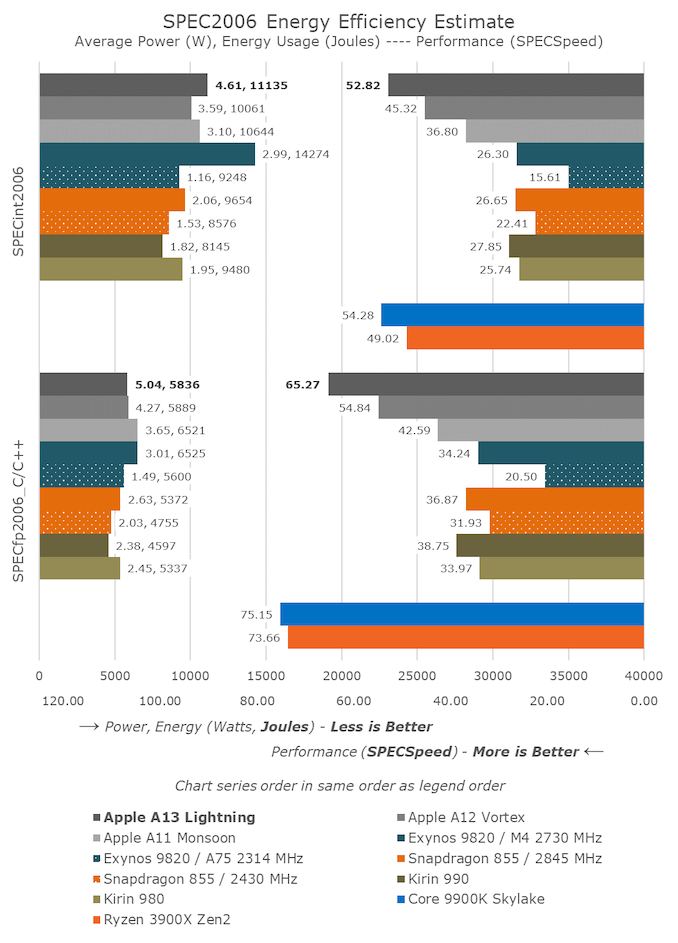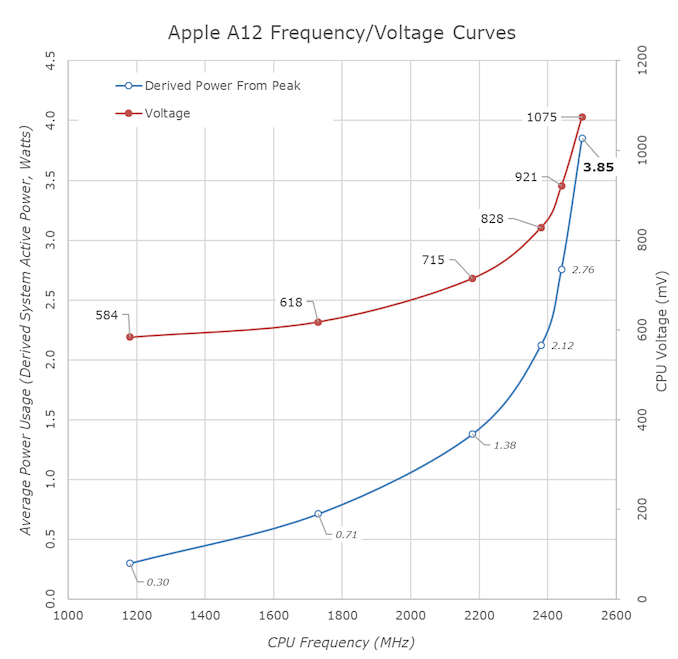The Apple iPhone 11, 11 Pro & 11 Pro Max Review: Performance, Battery, & Camera Elevated
by Andrei Frumusanu on October 16, 2019 8:30 AM ESTSPEC2006 Perf: Desktop Levels, New Mobile Power Heights
Given that the we didn’t see too many major changes in the microarchitecture of the large Lighting CPU cores, we wouldn’t expect a particularly large performance increase over the A12. However, the 6% clock increase alongside with a few percent improvement in IPC – thanks to improvements in the memory subsystems and core front-end – could, should, and does end up delivering around a 20% performance boost, which is consistent with what Apple is advertising.
I’m still falling back to SPEC2006 for the time being as I hadn’t had time to port and test 2017 for mobile devices yet – it’s something that’s in the pipeline for the near future.
In SPECint2006, the improvements in performance are relatively evenly distributed. On average we’re seeing a 17% increase in performance. The biggest gains were had in 471.omnetpp which is latency bound, and 403.gcc which puts more pressure onto the caches; these tests saw respective increases of 25 and 24%, which is quite significant.
The 456.hmmer score increases are the lowest at 9%. That workload is highly execution backend-bound, and, given that the Lightning cores didn’t see much changes in that regard, we’re mostly seeing minor IPC increases here along with the 6% increase in clock.
While the performance figures are quite straightforward and not revealing anything surprising, the power and efficiency figures on the other hand are extremely unexpected. In virtually all of the SPECint2006 tests, Apple has gone and increased the peak power draw of the A13 SoC; and so in many cases we’re almost 1W above the A12. Here at peak performance it seems the power increase was greater than the performance increase, and that’s why in almost all workloads the A13 ends up as less efficient than the A12.
In the SPECfp2006 workloads, we’re seeing a similar story. The performance increases by the A13 are respectable and average at 19% for the suite, with individual increases between 14 and 25%.
The total power use is quite alarming here, as we’re exceeding 5W for many workloads. In 470.lbm the chip went even higher, averaging 6.27W. If I had not been actively cooling the phone and purposefully attempting it not to throttle, it would be impossible for the chip to maintain this performance for prolonged periods.
Here we saw a few workloads that were more kind in terms of efficiency, so while power consumption is still notably increased, it’s more linear with performance. However in others, we’re still seeing an efficiency regression.
Above is a more detailed historical overview of performance across the SPEC workloads and our past tested SoCs. We’ve now included the latest high-end desktop CPUs as well to give context as to where the mobile is at in terms of absolute performance.
Overall, in terms of performance, the A13 and the Lightning cores are extremely fast. In the mobile space, there’s really no competition as the A13 posts almost double the performance of the next best non-Apple SoC. The difference is a little bit less in the floating-point suite, but again we’re not expecting any proper competition for at least another 2-3 years, and Apple isn’t standing still either.
Last year I’ve noted that the A12 was margins off the best desktop CPU cores. This year, the A13 has essentially matched best that AMD and Intel have to offer – in SPECint2006 at least. In SPECfp2006 the A13 is still roughly 15% behind.
In terms of power and efficiency, the A13 seemingly wasn’t a very successful iteration for Apple, at least when it comes to the efficiency at the chip’s peak performance state. The higher power draw should mean that the SoC and phone will be more prone to throttling and sensitive to temperatures.
One possible explanation for the quite shocking power figures is that for the A13, Apple is riding the far end of the frequency/voltage curve at the peak frequencies of the new Lightning cores. In the above graph we have an estimated power curve for last year’s A12 – here we can see that Apple is very conservative with voltage up until to the last few hundred MHz. It’s possible that for the A13 Apple was even more aggressive in the later frequency states.
The good news about such a hypothesis is that the A13, on average and in daily workloads, should be operating at significantly more efficient operating points. Apple’s marketing materials describe the A13 as being 20% faster along with also stating that it uses 30% less power than the A12, which unfortunately is phrased in a deceiving (or at least unclear) manner. While we suspect that a lot of people will interpret it to mean that A13 is 20% faster while simultaneously using 30% less power, it’s actually either one or the other. In effect what this means is that at the performance point equivalent to the peak performance of the A12, the A13 would use 30% less power. Given the steepness of Apple’s power curves, I can easily imagine this to be accurate.
Nevertheless, I do question why Apple decided to be so aggressive in terms of power this generation. The N7P process node used in this generation didn’t bring any major improvements, so it’s possible they were in a tough spot of deciding between increasing power or making due with more meager performance increases. Whatever the reason, in the end it doesn’t cause any practical issues for the iPhone 11’s as the chip’s thermal management is top notch.















242 Comments
View All Comments
lmcd - Wednesday, October 16, 2019 - link
Dunno what this is supposed to mean. Given how well Qualcomm chips do with Windows and the superior performance of Apple vs Qualcomm, you're really just spouting nonsense.joms_us - Wednesday, October 16, 2019 - link
Where is superiority you say? These apps does what Spec or GB does and yet iPhone A11 is not showing desktop-level performance here versus OP7https://www.youtube.com/watch?v=Ic8q1kPseVE
It is even laughable that this iPhone 11 is not faster than the older iPhone XS
https://www.youtube.com/watch?v=i-P0KRlbH1M
If A13 is truly superior than some desktop processors, why are we not seeing/hearing anything it replacing processors inside MBP? I am sure Apple can port it easily to Windows or Linux if they wanted to.
lmcd - Wednesday, October 16, 2019 - link
Did you actually just link GUI/responsiveness hand-testing videos? Why do you think those add anything to the conversation? Arguing about the performance of a given GUI library tells us nothing about the SoCs involved.A13 is truly superior to some binnings of laptop-class processors running at nearly 10x its power consumption. That's why it or a larger version of it (a future A13X) will run in a future iPad Pro that should perform in the same class as the Surface Pro 7 and Surface Pro X.
Yea, it won't win versus the top models. But it'll certainly beat the lower-end Pro 7, with an anemic i3. And that includes single-core performance.
So yea, it wouldn't be the top desktop processor, but it certainly can and will scale up to "desktop-class performance." It doesn't scale up to a premium experience at a desktop level yet, so there's no place for it yet in the Apple desktop product stack.
Diogene7 - Wednesday, October 16, 2019 - link
On a personal basis, I am much more interested by 1. fanless computers and 2. responsiveness (latency) over raw peak performance for a future laptop or even desktop computer as I am mostly using my computer to surf the web / watch videos.That is the reason I really, really like the idea of Qualcomm 8cx processor as in the Samsung Galaxy book S : Quiet laptop (no fan), thin, light, excellent battery life... The unknow is responsiveness : will the performance be good enough that lag won’t be felt more than a standard Intel / AMD laptop ?
If the responsiveness of a Qualcomm 8cx / future Apple A14 is good enough, then a fanless laptop, but also a fanless desktop has much, much appeal to myself !!!
If I was Apple, I would try to introduce ARM mac computers with both an Apple A14 / Apple A15 in combination with Storage Class Memory (SCM) to get never seen before low latency (excellent responsiveness) fanless mac computers : sure it would maybe take more time to do some intensive tasks on those computers (ex: video editing), but basic day to day task (launching Safari,...) would feel soooo much faster (like using a SSD everything faster compare to a mechanical HDD).
WinterCharm - Wednesday, October 16, 2019 - link
ARM macs are coming in 2020.You will see these chips in a mac. With active cooling they are going to DESTROY anything Intel and AMD have to offer.
Alistair - Wednesday, October 16, 2019 - link
These tests we are looking at are occurring at 2.6Ghz for the A13. And it is basically equal to the 4Ghz+ 9900k. Imagine the A13 running at 3.5Ghz, I think it already surpasses Intel easily enough.joms_us - Wednesday, October 16, 2019 - link
Nonsense, show us proof or it did not happen. Even a mere 2Ghz Ryzen is faster than any smartphone today.Alistair - Wednesday, October 16, 2019 - link
The iPhone uses 2 fast cores. Yes, it is equal to a dual core Ryzen or a dual core Intel CPU. I want Intel to be faster, but that would have required them to do ANYTHING meaningful since the i7-2700k came out instead of just repackaging the same CPU over and over.WinterCharm - Thursday, October 17, 2019 - link
The proof is right on page 4 of this article, or did you not read it?joms_us - Wednesday, October 16, 2019 - link
Crossing my fingers, I will be happy even if I can just drag and file my files here and there or perhaps compile my x86 apps. =D